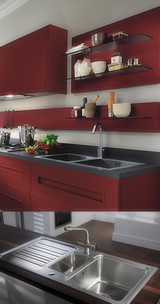Categories
How To Choose A Bathroom Sinks
Choosing the right bathroom sink involves more than just finding which one looks good. Sure, you want your sink to project your bathroom's style and some sinks, like vessel sinks, can actually be the focal point of the bathroom. But before you make any buying decisions there are a few things to consider
Whether you're remodeling, building new or just replacing an old sink will determine which direction to take when choosing a new bath sink. You'll need to be sure the sink you want is compatible with the faucet you currently have or will have, if you'll be buying both.
Other factors like installation type, configuration and material also come into play. Once you understand how to blend them with your own wants and needs, you'll be better equipped to make the right choice.
What Do I Need to Know about Bathroom Sinks? How to choose the right sinks from among the myriad of bathroom sinks?
Installation, Configuration and Material are the three important points to understand about bathroom sinks. They will help you choose the right sink that's compatible with your plumbing and faucet configuration as well as your lifestyle.
• Installation - how the sink is installed in your countertop or vanity (sometimes described as the "type" of sink)
• Configuration - its design relative to faucet compatibility, etc.
• Material - what material it's made from
Type of Installation
Undermount bathroom sinks are mounted underneath the counter or vanity top, making for an uninterrupted surface between the vanity top and the sink.
Self-rimming Sinks (Also named Top Mount Sinks and Drop-in Sinks), these sinks are placed in a cutout in the vanity top, secured in place by the rim of the sink. A variation of this is the tile-in sink which is a self-rimming sink that's used with a tiled countertop. The tiles usually fit over the sink's rim making a flush surface between the sink and tile.
The vessel sink is simply a free-standing bowl that sits on top of the vanity, though some can be mounted partially recessed into the countertop. It is essentially what its name implies -- a bowl. Though it may sound mundane, there are literally hundreds of varieties of vessel sinks, offering you unlimited design capacity。
Wall Mounted Sinks are affixed to the wall and work well in small bathrooms, allowing for usable space below the sink. Even if there's only room for a wastebasket, the space that it offers gives the bathroom a larger visual feels. Some wall mounted bath sinks feature a decorative cover that's installed over the plumbing and drain pipe.
Pedestal sinks are somewhat related to the wall mounted variety in that the sink basin is attached to the wall but rests on a pedestal that supports it from underneath. This is another type of bathroom sink that works well in small spaces since there's no need for a vanity. On the other hand, both pedestal and wall mounted bath sinks don't provide any storage space that you get with bathroom vanities.
Configuration
A bathroom sink's configuration refers in part to its installation method which we just described above, but also to how it's designed relative to the faucet it will be mated with. Such as, a three-hole faucet, meaning one that's made up of a spout and individual handles, requires a sink with three holes.
Material
Vitreous china and fireclay are similar in that they're clay-based ceramics. These materials also make durable sinks with easily cleaned surfaces. They can be chipped or cracked if they're knocked hard enough however.
We all have our preferences for a particular kind of sink material. Regardless of whatever material you fancy, keep in mind that it plays a role in the sink's durability and ease of maintenance.


